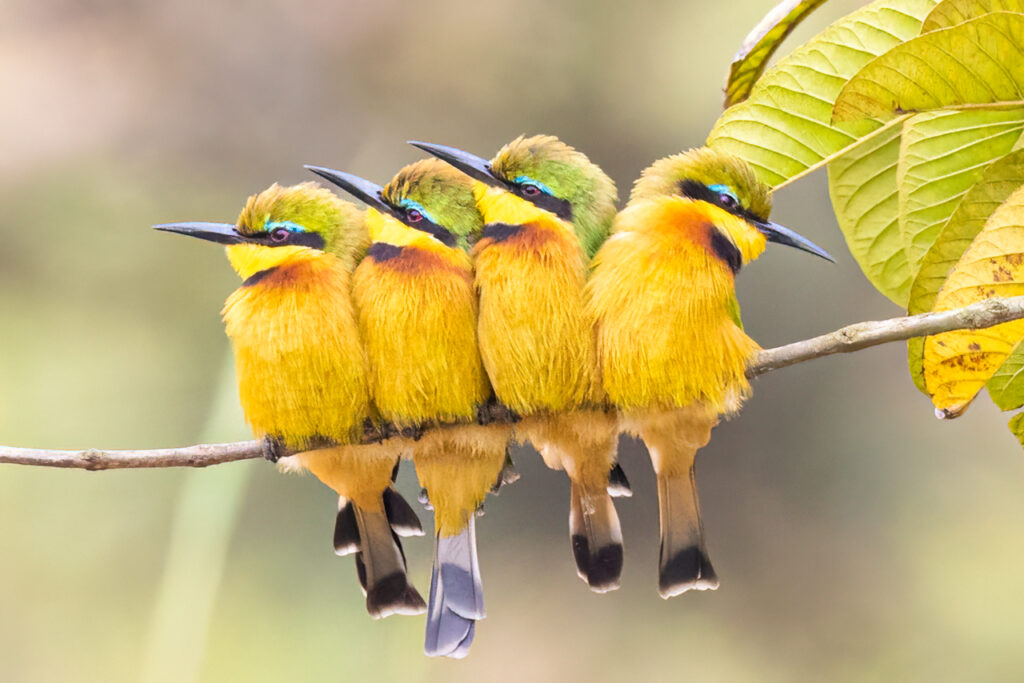All bee-eaters have bright and beautifully coloured plumage. Ten different bee-eater species can be found in Rwanda. These include the scarcely seen Blue-breasted Bee-eater and a single sighting of a Swallow-tailed Bee-eater. On the other end of the spectrum are the two most commonly seen species, the Little Bee-eater (the world’s smallest bee-eater) and the Cinnamon-chested Bee-eater, both are breeding residents that can be found in habitats across Rwanda. The Little Bee-eater prefers open grassland, savanna and lightly wooded areas, often near water. I regularly see them perched in small trees and bushes with exposed perches, along wetland edges and valley floors, usually within a few metres of the ground. Nyandungu Eco-Park in Kigali and Akagera National Park are great places to find them. The Cinnamon-chested Bee-eater prefers a higher elevation, often in excess of 1,500 m. Usually seen in wooded hillsides and forest edges, they like to perch higher than Little Bee-eaters. I have seen Cinnamon-chested Bee-eaters perched high in Eucalyptus trees on top of Mount Kigali and in Nyungwe National Park.
The European Bee-eater is a palearctic migratory species and is only seen here between August and April. After breeding across Europe and Asia they make the 6,000 – 7,500 km journey to the warmer weather and more abundant and accessible food on the African continent. They usually fly during the day (a diurnal migrant) in flocks of 20-40 and will often cross the Sahara Desert in a single flight. Once learned, their pleasant lilting calls betray their presence as they pass over Kigali during migration. Bee-eaters of all species roost communally, usually huddled together in groups along branches, and often facing the same way.
The diet of the various bee-eaters consists of flying insects, including wasps, hornets, moths, butterflies, damselflies, beetles, and as their name suggests they also eat bees. However, this family of birds has co-existed with bees for centuries and the impact they’ve had on their populations is minimal. To understand the global decline of bees and other insect populations we need to look closer to home. It is our (human) destruction of their habitat and industrial scale use of pesticides in agriculture that is to blame, not the birds. Bee-eaters catch the majority of their food whilst flying, or on the wing. This feeding strategy is known as hawking. Structural adaptations help the bee-eaters excel at this type of feeding. They have pointed wings and long tails, which enable fast flight and a high level of manoeuvrability. The bee-eaters beak is also curved downwards which allows it good visibility of its prey, all the way to the point of capture.
I have spent many an hour observing and photographing bee-eaters catching their food in this way. Bee-eaters are often found perched on an exposed branch scanning for flying insects. Once a prey item is sighted the bee-eater will launch after it, taking it in its beak, before returning to the same perch. Once back at the perch the prey item is rubbed and squeezed against the branch to soften it and remove any venom and sting. Prey items are swallowed whole. They are also ingested head first so that spines and scales don’t get stuck in their throat. Once the nutrients and other goodness have been digested, the scales and other indigestible parts are regurgitated as a pellet, much the same way kingfishers and owls do.
Like 90% of all bird species, bee-eaters are socially monogamous. This means they form a bond to raise their young together and whilst the bond between a pair can last for years, it does not mean they are ‘faithful’ to their partners, extra-pair mating is the norm for most birds. Both European and White-fronted Bee-eaters are cooperative breeders, meaning they will use ‘helpers’ to find food for their young and protect the nest site. Little Bee-eaters on the other hand are solitary breeders. Bee-eaters build their nests by excavating a tunnel in earth or sand banks. At the end of the tunnel they dig out a larger nesting chamber, which is separated from the tunnel by a lip to stop the eggs from rolling out. Bee-eaters dig with their beaks. Tunnels are excavated at an angle to prevent rain entering the nesting chamber.
Keep your eyes open for this brightly coloured family of birds, they are fascinating to watch, either huddled together on a branch or making darting flights hunting for their next meal.


Really interesting Will, they are gorgeous little birds, didn’t know there was so many varieties
Thanks for your comments Tracey, lots of variety both physically and how they behave! Really glad you enjoyed the article too!
Wow superb photos and so interesting to learn about each bird!
Thank you for your comments Linda, I’m really glad you enjoyed the article. I’ll upload more articles soon about a different family of Rwanda’s birds.